14 Types of Indoor & Outdoor Plants That Repel Spiders (With Pictures)
-

- Last updated:
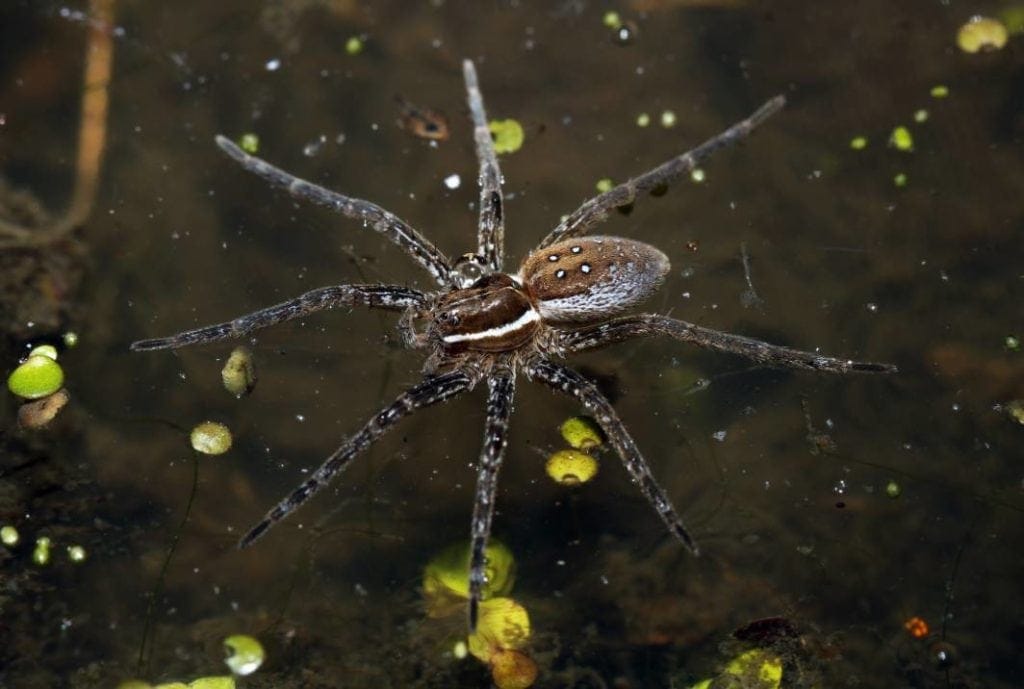
Nobody likes to have spiders around. While most species that live among us aren’t harmful, they aren’t exactly welcome guests in our yards and houses. So, how do you keep them away? There are many remedies against arachnids, but they usually take lots of effort or cost money. And that’s why today, our focus will be on the best spider-deterrent plants.
The following list includes 14 plants you can grow indoors and in a garden. They all look different and have unique properties. With that said, every single one of our top picks has proven to be a strong spider-repellent. Ready to kiss the unsightly spider webs goodbye? Then let’s get to planting!
The 14 Plants That Repel Spiders
1. Basil Plant

| Botanical Name: | Ocimum basilicum |
| Average Size: | 12–24 in x 12–24 in |
| Soil Type: | Well-drained, moist, moderately rich, 6.0–7.5 |
| Sun Exposure: | Full sun |
| Hardiness Zone: | 10-11 USDA |
Basil is a popular culinary herb. It’s got a lovely flavor and adds a nice “touch” to different meals. On top of that, basil helps with various heart conditions, arthritis, and bowel issues 1. It’s also commonly used against infections. So, why are spiders afraid of this herb? It’s all about the smell. We like it, but spiders find it to be repelling.
Mosquitoes and flies feel the same way. This is true for a wide range of basil plants, including the Thai and lemon varieties. Best grown indoors or in a heated garden (USDA zones 10–11), basil prefers full exposure to sun and well-drained, rich soil. Water it regularly and fertilize it once every 1–2 months.
2. Mint Plant
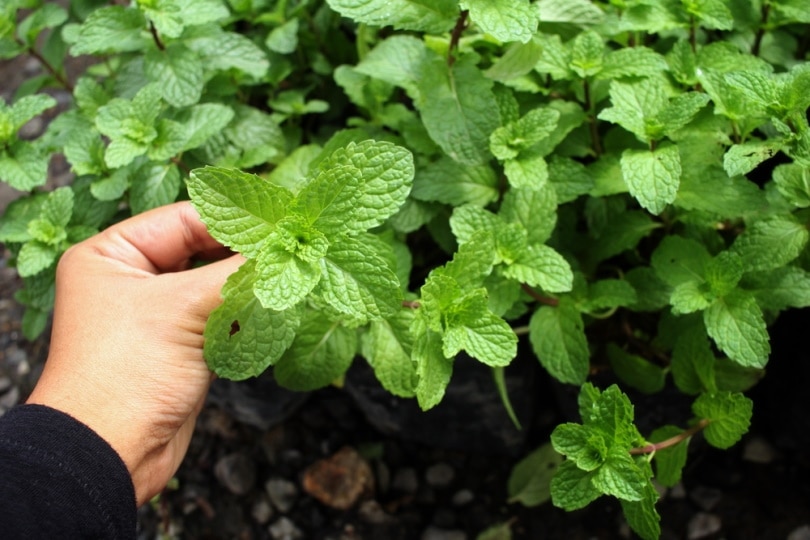
| Botanical Name: | Mentha |
| Average Size: | 12–18 in x 18–24 in |
| Soil Type: | Well-drained, moist, loamy, 6.0–7.0 |
| Sun Exposure: | Full sun/partial shade |
| Hardiness Zone: | 3-11 USDA |
In many ways, mint and basil are very much alike. They have similar characteristics and reach roughly the same height and width. Mint prefers a slightly richer and less acidic soil, though, and can survive in partial shade. In addition, it’s a lot more resistant to cold and will grow in less-than-ideal circumstances.
Mint has a very distinctive odor, too, and does a slightly better job of pushing spiders, ants, aphids, and other pests back. On the downside, it’s toxic to pets. Make sure to keep them away! Peppermint oil can be dangerous for people as well, especially if they have GERD.
3. Dill Plant
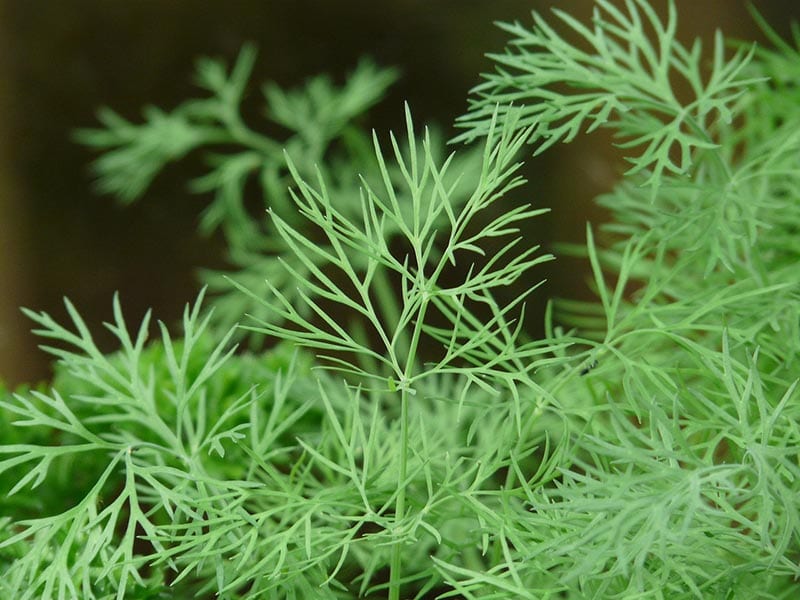
| Botanical Name: | Anethum graveolens |
| Average Size: | 3–5 ft x 2–3 ft |
| Soil Type: | Well-drained, moist, 6.5–7.0 |
| Sun Exposure: | Full sun |
| Hardiness Zone: | 2–11 USDA |
Gardeners across the globe use dill as a companion plant. It’s a fast grower and can be up to five feet tall. On the downside, at a certain moment, dill stops releasing odors that deter spiders. This usually happens 6–8 weeks after you sow the seeds. Does that mean this herb is a bad spider repellent? Not quite. To get long-term effects, just reseed it once in 1–1.5 months.
That will take some work, but dill is still an excellent natural solution to your spider problem. So, don’t rule it out. Besides, as a hardy herb, it can easily handle low temperatures and flourishes in poor soils. You don’t need to fertilize it every month to sustain steady growth.
4. Rosemary Plant
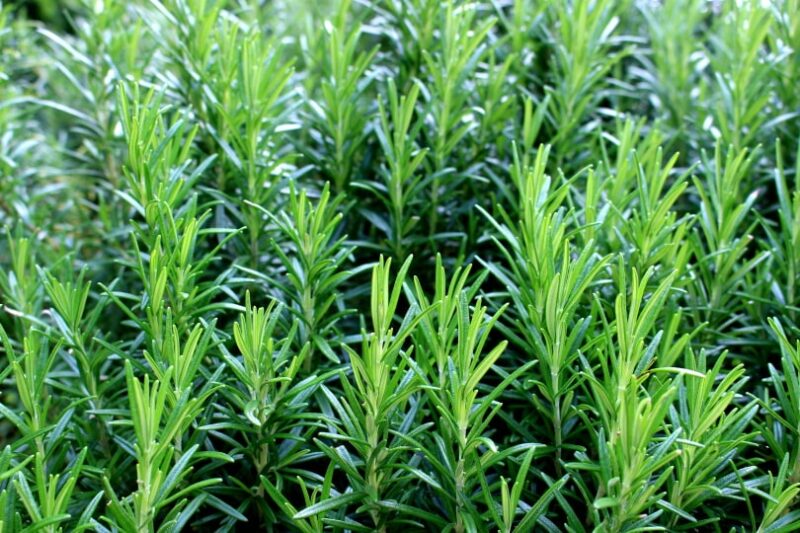
| Botanical Name: | Salvia rosmarinus |
| Average Size: | 2–6 ft x 2–4 ft |
| Soil Type: | Well-drained, loamy, sandy, 6.0–7.0 |
| Sun Exposure: | Full sun |
| Hardiness Zone: | 10–11 USDA |
Just like basil, rosemary dies in cold weather. It will, however, flourish in a container as a houseplant. As long as the soil is well-drained and loamy, and it gets 6–8 hours of sun, the rosemary will grow big. For maximum efficiency, place the pot near the windows that spiders use to enter your house. Rosemary doesn’t have a very strong smell, but for spiders, it is deterring and confusing.
5. Citronella Grass Plant
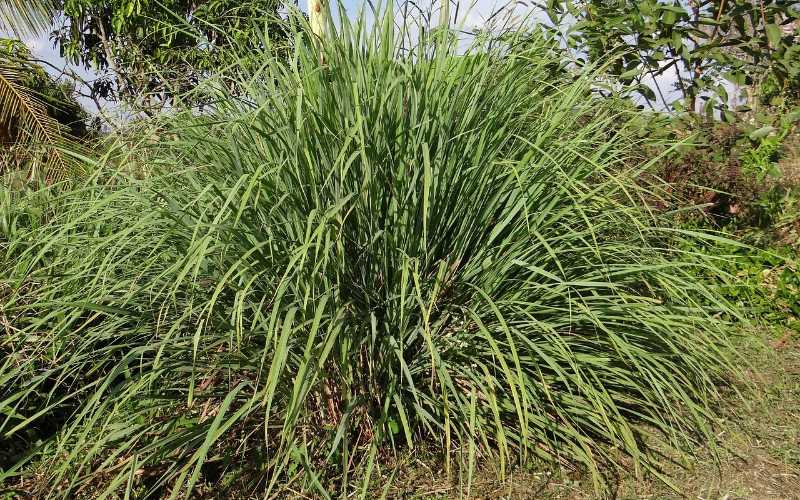
| Botanical Name: | Cymbopogon nardus |
| Average Size: | 5–6 ft x 4 ft |
| Soil Type: | Well-drained, moist, loamy, 6.0–6.5 |
| Sun Exposure: | Full sun/partial shade |
| Hardiness Zone: | 10–12 USDA |
Tired of having crawlers all over the floor and in the cupboards? Citronella grass (also known as lemongrass) might help you with that. It’s rich in lemon oil that puts fear into the hearts and minds of spiders, mosquitoes, and ants. If you live somewhere in the South, you can grow it outdoors—the plant will appreciate full exposure to the sun. But, it’s only hardy to zones 10–12.
That means it won’t survive the winter up North. Citronella grass is rather tall and reaches six feet in height. It’s not very pretty, though.
6. Chrysanthemum Plant

| Botanical Name: | Chrysanthemum morifolium |
| Average Size: | 2–4 ft x 1–2 ft |
| Soil Type: | Well-drained, moist, rich, 5.7–6.2 |
| Sun Exposure: | Full sun/partial shade |
| Hardiness Zone: | 3–9 USDA |
In contrast to the citronella grass, chrysanthemums (AKA mums) are incredibly beautiful. And they have a pleasant smell, which makes them perfect houseplants. Hardy to zones 3–9, mums won’t freeze over in the early days of winter but might have to be moved inside during the cold months. We recommend starting them in the fall, as that’s when spiders are most active.
The arachnids are afraid of pyrethrin—a compound that chrysanthemums have plenty of.
7. Lemon Verbena Plant
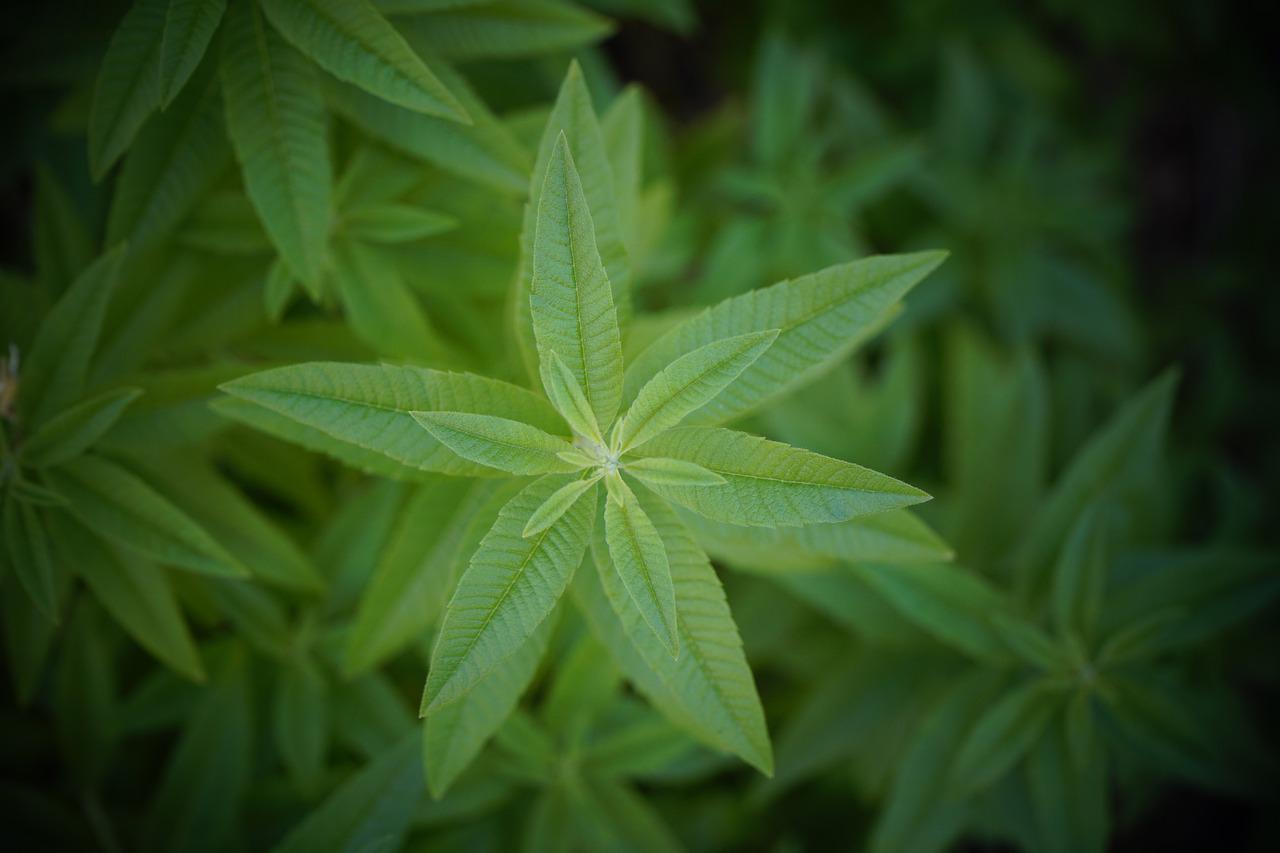
| Botanical Name: | Aloysia citriodora |
| Average Size: | 2–3 ft x 5–6 ft |
| Soil Type: | Well-drained, moist, loamy, fertile, 6.1–7.0 |
| Sun Exposure: | Full sun |
| Hardiness Zone: | 8–11 USDA |
Lemon Verbena is a widely used culinary herb. It goes great with various drinks, desserts, and meals. This plant is native to Chile and Argentina, and that means it’s not capable of handling harsh climates. So, you’ll have to move it indoors for most of the winter. And what about the scent—is it capable of keeping spiders at bay?
Yes, the Verbena odor is strong enough to overpower spiders both in the garden (during the warm days, of course) and inside the house.
8. Lemon Balm Plant

| Botanical Name: | Melissa officinalis |
| Average Size: | 1–2 ft x 1–3 ft |
| Soil Type: | Well-drained, moist, sandy, 6.5–7.0 |
| Sun Exposure: | Full sun/partial shade |
| Hardiness Zone: | 4–9 USDA |
And what do we have here? Lemon Balm is a fast grower that tends to spread. To contain it, consider using a garden bed or a large pot. To ensure proper growth, make sure the soil is not only well-drained and moist but also sandy. Full sun is preferred, yet this plant will grow in shade as well. The most important thing to remember here is that the more fertilizer you add, the weaker the balm’s odor will be.
As a result, it will become less efficient against spiders, aphids, ants, and other common pests.
9. Lavender Plant
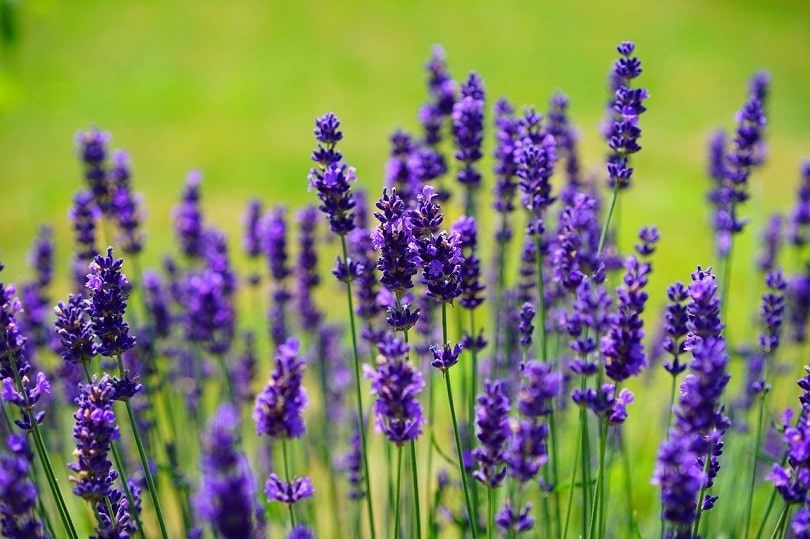
| Botanical Name: | Lavandula |
| Average Size: | 2–3 ft x 2–4 ft |
| Soil Type: | Well-drained, poor, dry, moderately rich, 6.0–8.0 |
| Sun Exposure: | Full sun |
| Hardiness Zone: | 5–8 USDA |
Lavender is a rough, tough, and fast-growing wildflower that flourishes in poor and dry soil. It prefers full sun, though, and can only handle so much cold (hardy to zones 5–8). To turn your garden and house into a restricted zone for spiders, plant the English lavender. Spiders hate its smell the most. But how do you cover every single entrance in the house?
By making a spray, of course! Mix the essential oil from lavender with water and put it in a spray bottle.
10. Chives Plant
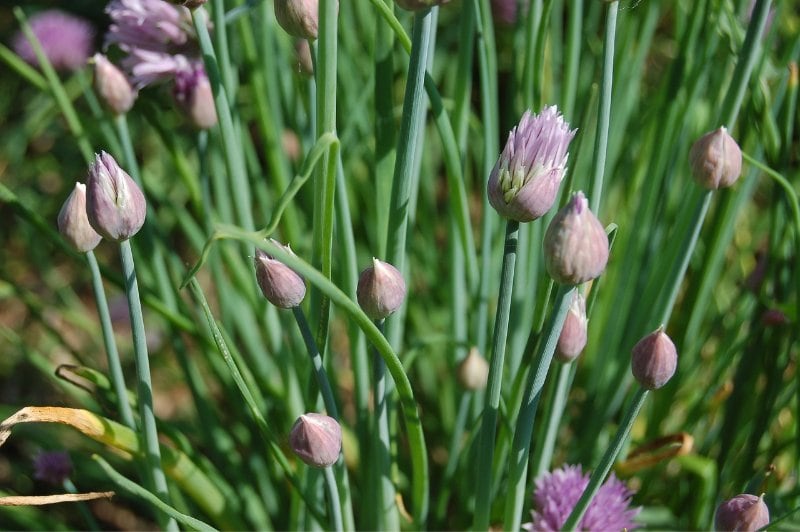
| Botanical Name: | Allium schoenoprasum |
| Average Size: | 10–15 in x 10–15 in |
| Soil Type: | Well-drained, sandy, loamy, rich, 6.0–7.0 |
| Sun Exposure: | Full sun/partial shade |
| Hardiness Zone: | 3–9 USDA |
Chives are the “distant cousins” to garlic, onions, and shallots and have a distinctive scent. Spiders turn around and leave when they smell it, which is exactly what we’re looking for. On the downside, chives aren’t nearly as beautiful as lilacs, roses, or marigolds. That’s why they’re mostly grown in gardens, not indoors. Another big con: these plants are toxic to most domestic animals.
The side effects include difficulty breathing, an elevated heart rate, vomiting, and even damaged blood cells.
11. Sage Plant

| Botanical Name: | Salvia officinalis |
| Average Size: | 2–3 ft x 2–3 ft |
| Soil Type: | Well-drained, sandy, loamy, 6.5–7.5 |
| Sun Exposure: | Full sun/partial shade |
| Hardiness Zone: | 4–11 USDA |
Just like lemon balm, sage loses some of its spider-repelling properties when the soil is overly fertilized. So, it might be a good idea to just go with well-drained, loamy, and a bit sandy soil instead. Only water the plant when it gets really dry during the hot months. For the best results, go with the Cleveland sage. It’s proven to be highly effective against spiders.
12. Eucalyptus Plant
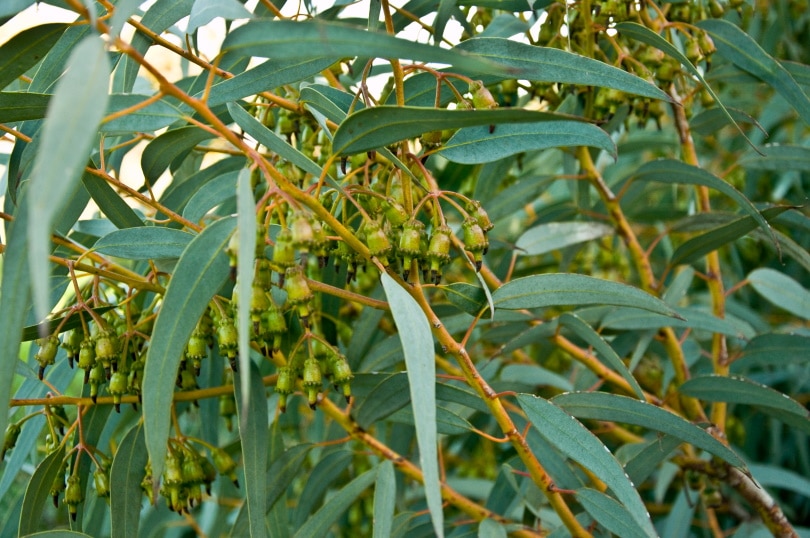
| Botanical Name: | Eucalyptus cinerea |
| Average Size: | 6–55 ft x 2–15 ft |
| Soil Type: | Well-drained, moist, 4.5–7.5 |
| Sun Exposure: | Full sun |
| Hardiness Zone: | 8–11 USDA |
Outdoors, eucalyptus can get 60 feet tall, but when grown indoors, the average height is 5–10 feet. This tree mostly prefers warmer climates and thrives under the full sun. And, like most entries on the list, eucalyptus has a smell that’s pleasant for us but unbearable for spiders. Unfortunately, the leaves are known to cause skin irritation for both humans and domestic animals.
Don’t let your cat or dog eat eucalyptus leaves! The side effects tend to be rather serious.
13. Marigolds Plant
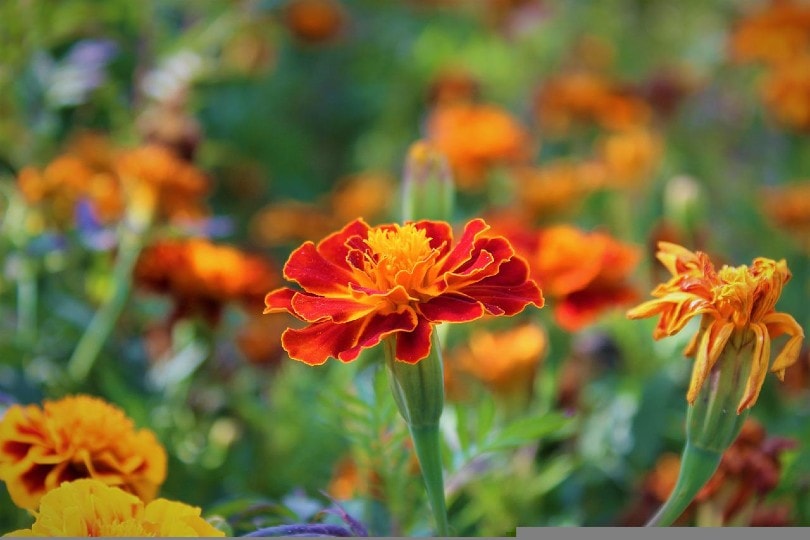
| Botanical Name: | Tagetes |
| Average Size: | 4–34 in x 6–18 in |
| Soil Type: | Well-drained, loamy, moderately fertile, 6.2–7.2 |
| Sun Exposure: | Full sun |
| Hardiness Zone: | 2–11 USDA |
First, marigolds are beautiful. Second, they are hardy to zones from 2 to 11 and won’t wither away when the hot summer days are over. Along with that, they do a great job of repelling spiders with a musky, pungent scent (especially the Mexican variety). Now, it’s not the best smell out there for a human, but for spiders, it’s a major turn-off.
Plant marigolds in loamy and fertile soil, and they’ll grow into lovely flowers in no time.
14. Catnip Plant
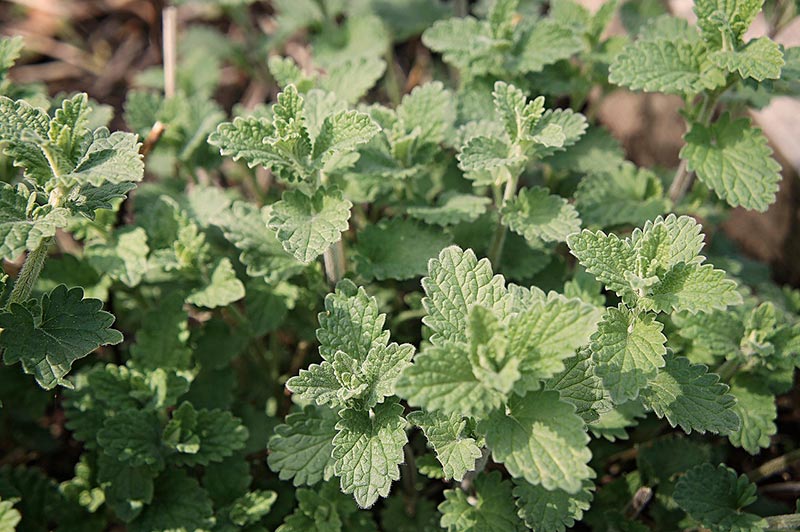
| Botanical Name: | Nepeta cataria |
| Average Size: | 2–3 ft x 2–3 ft |
| Soil Type: | Well-drained, sandy, loamy, 5.0–7.8 |
| Sun Exposure: | Full sun/partial shade |
| Hardiness Zone: | 3–9 USDA |
Resilient, quick to grow, and up to three feet tall, catnip flourishes equally well in shade and sun. To prevent the plant from taking over the entire garden, put it in a container. Catnip comes from the mint family and is famous for its potent smell that makes many insects stay away. For spiders, it’s an even bigger issue. In contrast, this herb makes cats very happy.
Do Spiders Feed on Plants?
The short answer is no; spiders aren’t in the business of ravishing plants. Instead, they eat the bugs that feed on the leaves of flowers and vegetables. The list includes beetles, aphids, flies, and mosquitoes. Spiders will devour these insects before they have the time to do any meaningful harm. So, yes, in contrast to popular belief, spiders are actually a strong remedy against pests.
What Else Can You Do Against Spiders?
- Keep the garden clean. Spiders are big fans of setting shop in dark spots. So, all you have to do is keep the property clean of wood piles, leaves, grass, and debris. By turning the garden into an unwelcoming area for the spiders, you’ll automatically keep them away from the house as well.
- Get rid of the web. If the eight-legged troublemakers made it into your home, the #1 task would be to remove their webs. Spiders use it to lure and trap bugs. The name of the game here is consistency. Keep removing their webs throughout the house, and one day, they’ll stop weaving them.
- DE: the heavy artillery. Diatomaceous earth is a powerful insecticide. It’s cheap, easy to apply, and is often used by gardeners and landscapers against destructive bugs. DE is capable of killing some of the biggest and strongest insects. Spiders won’t be able to resist it, either. But DE is harmless to humans and pets.
- Go with white vinegar. Got some vinegar in the kitchen? Use it for pest control. It’s got a specific smell that spiders shy away from. Spread some vinegar near the windows, doors, and other entrances that spiders often visit. You can use a spray bottle for that. Citrus and lemon will work as well.
- Keep the garden lights off. Bright lights are like a magnet for many bugs. This doesn’t apply to spiders, but if they see gnats, flies, and other insects flying around the lights, they will “join the party”. Make a habit of turning the lights off whenever you can.
In Conclusion
Most spiders feed on insects—that’s their primary source of food. This is why they like to hang around gardens that attract lots of bugs. And when it gets cold, spiders find their way inside the house. Now, while they don’t bite humans, their webs do collect dust and ruin the view. Spiders running across the floor aren’t a sight for sore eyes, either.
Fortunately, there are lots of plants out there that scare them away with a strong scent. You can grow these plants in pots or containers indoors or in garden beds and planter boxes outdoors. Put them right next to the windows and doors, and watch the spider demographic on your property plummet!
- NMSU.Edu – Dealing with spider mites on houseplants
- Plants That Repel Spiders From Your Home or Garden
- 8 fragrant houseplants that are proven to repel spiders
- MasterClass – 6 Natural Ways to Ward off Spiders
- Web.MD – Diatomaceous Earth Uses, Side Effects
- National Geographic – Why insects are attracted to lights
- MasterClass – Dill Companion Planting Guide
- Gardenia – Strongest Scented English Lavender
- Web.MD – Eucalyptus Uses, Side Effects
- NPIC.Orst.Edu – Oil of Citronella
- NPIC.Orst.Edu – What are Pyrethrins
- Web.MD – Health Benefits of Basil
- ASPCA – Animal Poison Control, Mint
- NIH – Risk factors for GED: the role of diet
- ASPCA – Animal Poison Control, Chives
- PetMD – What Does Catnip Do to Cats?
- https://www.masterclass.com/articles/dill-companion-planting-guide
- https://www.housebeautiful.com/uk/garden/plants/g37619305/plants-repel-spiders/
Featured Image Credit: Michael Benard, Shutterstock
Contents


